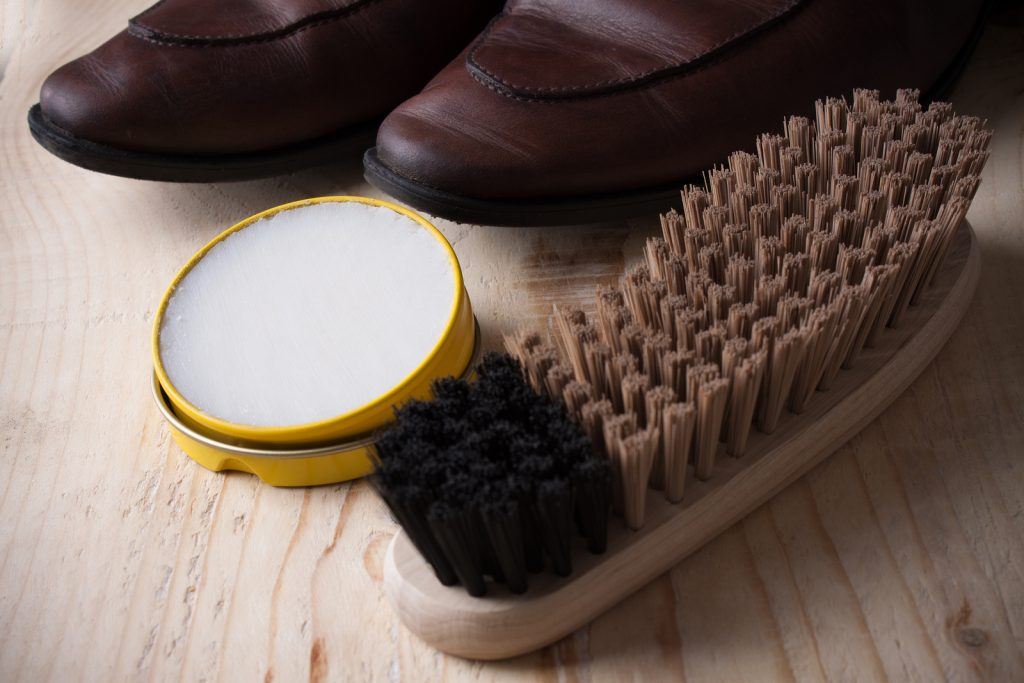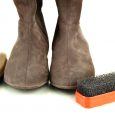 We’ve all heard the importance of wearing a nice, well-kept pair of shoes. About how other people can tell a lot about you just by looking at your shoes, and how they are an integral part of the overall first impression. And we know how important first impressions can be. Just walk into an important job interview while sporting a scuffed, dirty, and worn pair of leather shoes. You’re already down a strike before you step to the plate.
We’ve all heard the importance of wearing a nice, well-kept pair of shoes. About how other people can tell a lot about you just by looking at your shoes, and how they are an integral part of the overall first impression. And we know how important first impressions can be. Just walk into an important job interview while sporting a scuffed, dirty, and worn pair of leather shoes. You’re already down a strike before you step to the plate.
We all know that. You know that. That’s why a quality pair of leather shoes is not only a wise investment but also a foot in the door in many situations. It’s also why an investment that important is worth protecting at all costs. It’s like investing in a good car. You don’t drive it until it’s covered in dirt and then do nothing about it. Hopefully, you don’t even let it get fully filthy. You want it to last. You want it to look good – always. Others will notice.
Well, the good news is that taking care of your leather shoes isn’t rocket science. But it does require the right tools, a few easily graspable techniques, and the determination to make your investment last a long, long time. And leather shoes can last a long, long time with the proper care. We’re talking years and years.
The Anatomy of a Shoe
Hey, what we learned about our own human anatomies way back in the day is knowledge that sticks with us for a lifetime. Maybe it doesn’t factor in each of your day-to-day moments, but it is important to know how the various limbs and organs and nervous system all work together. OK, taking care of your shoes might not be quite as important when in the grand scheme of things, but knowing what parts fit together to create a leather shoe isn’t wasted knowledge, and will help you get a better understanding of your investment. If nothing else, it may provide you with a few factoids that you can impress your friends with.
- In its most basic sense, a shoe consists of an upper and lower. The two parts are held together by a sturdy layer called a “welt.”
- The shoe’s upper – known as the body – is also divided into a front portion (vamp) and back (quarter) and is traditionally made of leather. Especially for our purposes here.
- The lower part is commonly referred to as the heel but actually is composed of the outsole (the part that makes contact with the ground), the shank (keeps the shoe from buckling), and the heel itself, which is the raised platform that helps cushion your feet from impact.
- The insole is the material inside which separates the foot from the sole. It’s also there to add comfort.
How To Care For Leather Shoes
Anatomy lesson complete, and we hope you know your shoe on a more fundamental level now, let’s get down to business. That is, the business of taking care of those leather shoes that you’re so proud of and rightfully want to last for years to come. Think about it. You may spend $300, or more, for high-quality leather shoes, but with the right care, your investment will pay for itself. Or, you could buy a cheaper pair of shoes and hope you get a couple of good years out of them.
So, what’s the secret to a long and happy life with your new leather shoes? Like any relationship, it needs to have equal parts love, affection, care, and commitment. Note: We’re working under the assumption that the shoes you own are full-grain leather or calfskin. Suede is another story, as are reptile and cordovan. Proper care is a little different for each.
First, a few helpful hints:
Toss Out The Shoe Box
Don’t make the mistake storing your shoe in their original box, at least not for any significant period of time. The humidity can wreak havoc on the material.
What To Do With Wet Shoes
Accidentally stepped into a puddle or get caught in a rainstorm? Get those soaked shoes home as soon as possible and stuff them with newspaper. And whatever you do, don’t place them in front of direct heat to dry, because the heat can dry out the leather and cause it to crack.
Use A Shoe Horn
That thing you do when you try to squeeze your foot into a shoe with using a shoe horn? It wreaks havoc on the heels of your shoes.
Use A Shoe Tree
Using a shoe tree is one of the most important things you can do to help prolong the life of your favorite leather shoes. For starters, they absorb moisture and odors. They also retain the shape of the shoe and reduce creases. The bottom line: you need to have one.
Give Them a Breather
True, with proper care your leather shoes should last a long time. But don’t run them into the ground, so to speak. Give them a day off every now and then and wear your next favorite pair of shoes.
1. Waterproofing
Do not pass Go until you’ve bought a spray repellent. It is an essential part of your shoe-care arsenal and is the best way to keep the elements from shortening your shoes’ lifespan. Most spray repellents provide protection for about six months, but you know you’ll need a new coat of the stuff when water stops beading up on your shoes.
How to do it – First, wipe your shoes down with a warm sponge. This will warm the leather and make it more porous, which will, in turn, improve the leather’s ability to absorb the spray repellent of your choice. You can even use a hair dryer – but only on low heat, and not for long – to gently heat the shoes before and after you apply the spray.
2. Conditioning
Your shoes will dry out over time if left to their own devices. That’s why it’s wise to add a bit of conditioner to them and prevent flaking and wrinkling. How often you apply conditioner depends a lot on where you live; if you live in a hot and humid climate and are outdoors a lot, then applying conditioner every two weeks certainly wouldn’t hurt. Otherwise, once a month should suffice.
How to do it – Using a cotton cloth, liberally apply a cream conditioner into the shoe and work it in the leather with circular motions. Let the conditioner sit for 20 minutes and then rub with a shoe brush to get rid of any excess cream.
3. Polishing
 Now comes the fun part – polishing those shoes into a shine that would make a Marine drill sergeant happy. Of course, it all depends on your taste, i.e., whether you’re looking for a mirror shine or just a nice buff that still indicates you put forth the effort. Note: There are two types of polish to choose from. The first is a cream polish that’s great for rejuvenating the color. The other one is a wax polish (beeswax is recommended) that’s great for a stunning surface shine.
Now comes the fun part – polishing those shoes into a shine that would make a Marine drill sergeant happy. Of course, it all depends on your taste, i.e., whether you’re looking for a mirror shine or just a nice buff that still indicates you put forth the effort. Note: There are two types of polish to choose from. The first is a cream polish that’s great for rejuvenating the color. The other one is a wax polish (beeswax is recommended) that’s great for a stunning surface shine.
How to do it – Set aside a half-hour of your time. C’mon, we can all spare 30 minutes. After all, it’s all about making your shoes look great while extending their lifespan. All you’ll need is shoe polish, one that’s as close to the color of your shoes as you can get, a shoe shine brush, a soft cloth (an old cotton t-shirt will do) and something to protect your workplace, such as old newspapers, because the last thing you want is shoe polish on your carpet.
Step 1: Use a brush or damp rag to wipe the dirt and other residues off of your shoes. Just make sure your shoes are dry before you begin to polish them.
Step 2: Rub your cloth in the polish until it has a splotch of polish on it that’s about the size of a half-dollar. Then polish the entire surface of the shoe while using a circular motion. The toe and heel are key spots to keep an eye on because they most bear the burden of your daily wear. Once you’ve finished polishing, let each shoe dry for 15 minutes.
Step 3: Now for the final stage of your almost good-as-new shoes. Grab your brush and use short, even strokes to remove excess polish while giving your shoes the kind of shine that will take away the ‘almost’ part of good-as-new. Don’t be afraid to put a little elbow grease into it; the heat generated by your brushing will help produce that lustrous shine.
4. Storing Them
We’ve already touched on shoe trees, but they’re important enough to mention again. Once you’re home, get your shoes on a shoe tree as soon as possible. This will help maintain your shoe’s original shape, and will help prevent shrinkage and creases.
And there you have it. The result of your extra effort is a pair of great-looking shoes that will become your companion for years to come. Shoes are important. When it comes to your own leather shoes, make sure you’re always putting your best foot forward.














